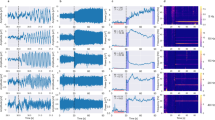Abstract
Steady-state stimulation is a useful paradigm in many physiologic and clinical situations, for ERG, Pattern-ERG and VEP. One of the advantages is the easy evaluation of the response via Fourier analysis. However, the question whether a given response is statistically significant or not has received little attention so far, although it is especially relevant in high noise, low amplitude recordings, as often occur in pathologic conditions. A given response is statistically significant if it is unlikely that its value is due to noise fluctuations. Thus appropriate estimates of noise and response are required. We have analytically derived formulas for the statistical significance of a given signal-to-noise-ratio s, based on two different estimates of noise: (1) Noise estimate by a `no stimulus' recording, or by a `±average'. The former needs an additional recording, the latter can simultaneously be calculated as the standard average. (2) Noise is estimated as the average of the two neighboring spectral lines (one below, and one above the response frequency). Analytical solutions were obtained for both noise estimates that can easily be evaluated in all appropriate recordings. Noise estimate (1) performs much poorer than noise estimate (2), as can be seen from the following landmark values: Typical significance levels of 5%, 1%, and 0.1% require s values of 4.36, 9.95, and 31.6 (1), and 2.82, 4.55, and 8.40 (2). The noise estimate based on the neighboring frequencies can be easily applied after recording, provided that the noise spectrum is reasonably smooth around the response and frequency-overspill was avoided. It allows a quantitative assessment of low responses in physiological threshold analyses and pathological conditions, e.g., `submicrovolt flicker-ERG'.
Similar content being viewed by others
References
Alberhseim WJ. A closed-form approximation to Robertson's detection characteristics. Proc IEEE 1981; 69: 839.
Bach M, Gerling J. Retinal and cortical activity in human subjects during color flicker fusion. Vision Res 1992; 32: 1219–23.
Bach M, Rupp V, Meigen T. Yet another VEP-based visual acuity test. Invest Ophthalmol Vis Sci (ARVO Suppl.) 1998; 39: S184 (Number 879).
Birch DG, Sandberg MA. Submicrovolt full-field cone electroretinograms: artifacts and reproducibility. Doc Ophthalmol 1997; 92: 269-80.
Harding GFA, Odom JV, Spileers W, Spekreijse H. Standard for visual evoked potentials. Vision Res 1996; 36: 3567–72.
Kusel R, Wesemann W, Rassow B. A new laser interferometer for the stimulation of pattern-reversal visual evoked potentials. Clin Phys Physiol Meas 1985; 6(3): 239–46.
Marmor MF, Holder GE, Porciatti V, Trick GL, Zrenner E. Guidelines for basic pattern electroretinography. Recommendations by the International Society for Clinical Electrophysiology of Vision. Doc Ophthalmol 1996; 91: 291–8.
Marmor MF, Zrenner E. Standard for clinical electrophysiology. Doc Ophthalmol 1995; 89: 199–210.
Mast J, Victor JD. Fluctuations of steady-state VEPs: interaction of driven evoked potentials and the EEG. Electroenceph Clin Neurophysiol 1991; 78: 389–401.
Morrone C, Porciatti V, Fiorentini A, Burr DC. Pattern-reversal electroretinogram in response to chromatic stimuli: I. Humans. Visual Neurosci 1994; 11: 861–71.
Norcia AM, Tyler CW, Hamer RD, Wesemann W. Measurement of spatial contrast sensitivity with the swept contrast VEP. Vision Res 1989; 29: 627–37.
Papoulis A. Probability, random variables, and stochastic processes. New York: McGraw-Hill, 1984.
Regan D. A study of the visual system by the correlation of light stimuli and evoked electrical responses. Ph.D. thesis, University of London, 1964.
Regan D. Some characteristics of average steady-state and transient responses evoked by modulated light. Electroencephal Clin Neurophysiol 1966; 20: 238–48.
Regan D. Human brain electrophysiology. Evoked potentials and evoked magnetic fields in science and medicine. New York, Amsterdam, London: Elsevier, 1989.
Rice SO. Statistical properties of a sine wave plus random noise. The Bell System Tech J 1948; 27: 109–57.
Robertson GH. Operating characteristics for a linear detector of CW signals in narrowband gaussian noise. The Bell System Tech J 1967; 46: 755–74.
Schimmel H.The (±)-reference: Accuracy of estimated mean components in average response studies. Science 1967; 157: 92–4.
Sieving PA, Arnold EB, Jamison J, Liepa A, Coats C. Submicrovolt flicker electroretinogram: Cycle-by-cycle recording of multiple harmonics with statistical estimation of measurement uncertainty. Inv Ophthalmol Vis Sci 1998; 39: 1462–9.
Simon F, Rassow B. Measurements of spatial interaction and visual acuity using visual evoked potentials elicited by simultaneous multifrequency stimulation. Clin Vision Sci 1986; 1: 287–302.
Strasburger H. The analysis of steady state evoked potentials revisited. Clin Vision Sci 1987; 1: 245–56.
Strasburger H, Murray IJ, Remky A. Sustained and transient mechanisms in the steadystate visual evoked potential: Onset presentation compared to pattern reversal. Clin. Vision Sci. 1993: 8: 211–34.
Victor JD. Mast J. A new statistic for steady-state evoked potentials. Electroenceph Clin Neurophysiol 1991; 78: 378–88
Rights and permissions
About this article
Cite this article
Meigen, T., Bach, M. On the statistical significance of electrophysiological steady-state responses. Doc Ophthalmol 98, 207–232 (1999). https://doi.org/10.1023/A:1002097208337
Issue Date:
DOI: https://doi.org/10.1023/A:1002097208337




